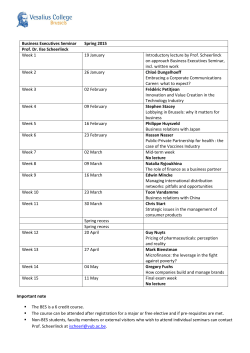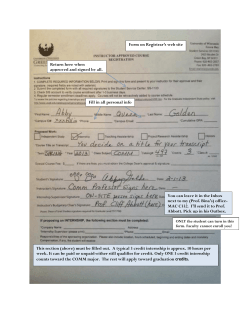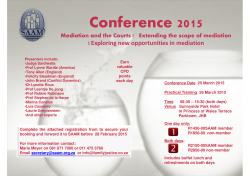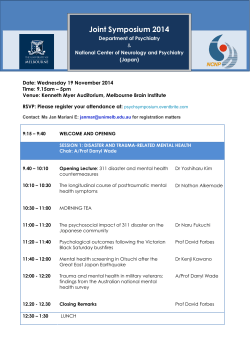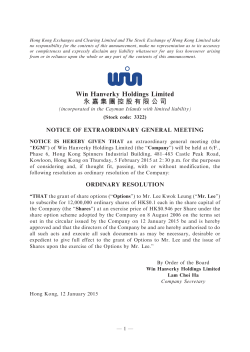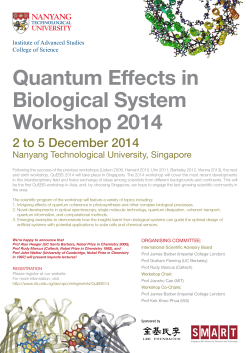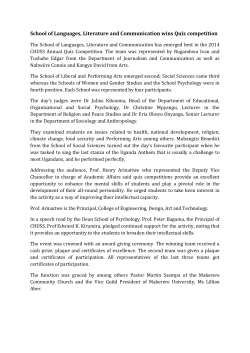
ISOM3230 Spring 2015
ISOM3230 Spring2015 ISOM3230: Business Applications Programming [3‐0‐1:3] Course goals This course will provide you with skills and knowledge of business applications programming and experience in designing and developing business applications. Learning outcomes By the end of this course, you will be able to: 1. 2. 3. 4. 5. 6. explain the relationships among computer, programming, and programming language apply programming concepts to solve business problems describe the logic and flows of given programs predict the output of a program write programs with common programming practices identify and fix logical and run‐time errors in programs Course description This course is designed to train students to understand programming, in particular business applications programming. Students will learn why we need to use programming in their professions and why they build business applications, how business applications influence business workflows, how programming could be more beneficial and useful in business applications, and so on. Students will learn basic programming syntax and structure, and how to build basic business applications using high‐level programming languages. Teaching approach This is a blended learning course, which applies the basic concepts of flipped‐classroom model. In this course, students are required to watch video lecture before applying the knowledge and skills acquired from the video lecture in the lecture and lab. After watching video lecture, students are required to answer questions in Quizzes, and also participate in discussion forum. This will ensure students to possess sufficient knowledge and skill for in‐class exercises and lab works. Lecture and Lab are used for practicing programming skills with questions and exercises. The following is the study pattern for one week of study. ByJamesKwok Page1 ISOM3230 Spring2015 In general, the teaching approach of this course is based on the notion of sustained, deep learning by applying knowledge through programming, hands‐on practices, and individual assignments. Lecture sessions are also structured to engage the students in learning proactively (pre‐readings, pre‐class assignments, and pre‐class video lectures), actively (in‐class exercises of programming and in‐class discussion of business applications) and reflectively (in‐class discussion of personal views through the answers of in‐class exercises). The individual assignments and the group assignment are there to deepen student’s learning through knowledge application while at the same time providing students with opportunities to develop essential workplace skills such as critical thinking, written and oral communications, team work, and lifelong learning. Teaching & Learning Activities Lecture Laboratory Assignment Roles in the Course Explain key concepts to students using an active learning approach, video lecture, forum discussion, in‐ class exercise, and after‐class discussion of questions. Apply concepts presented in video lectures to hands‐on exercises. It requires students to apply their understanding in programming to solve business problems. Course Learning Outcomes addressed 1, 2, 3, 4, 5, 6 2, 3, 4, 5, 6 2, 3, 4, 5, 6 ByJamesKwok Page2 ISOM3230 Spring2015 Assessment scheme An inevitable part of this end of any university course is the evaluation, and the grade. Actually, in any course, the most important evaluation is your self‐evaluation. How many new and useful ideas and skills did you learn from the course? Has the course changed your views about yourself, work groups and organizations? If so, your efforts here will have paid off. Your course goals will be assessed in the following manner, and the percentage of your grade may be broken down as below: Components A. Midterm Exam B. Final Exam C. Lab Assessment Learning goals assessed 2, 3, 4, 5, 6 2, 3, 4, 5, 6 2, 3, 4 ,5, 6 Percentage of the grade 20% 30% 8% D. Assignment E. Online Quiz (1% each) And Discussion (1% overall) TOTAL: 2, 3, 4, 5, 6 2, 3, 4, 5, 6 30% 12% 100% A. Midterm Exam (20%) All course materials, assigned readings, lecture notes, exercises, and case discussions are subject to the examination. B. Final Exam (30%) The final exam is non‐cumulative. C. Lab Assessment (8%) Students are required to show our TA their understandings of lab materials through lab demonstrations. Throughout the semester, each student will perform TWO lab demonstrations (one will be before midterm exam and the other one will be before final exam) and students need to inform TAs their available time slots. Then TA will randomly selects a group of students for each lab demonstration and informs the selected students one day in advance about the details of lab demonstration. The duration of lab demonstration is 5 minutes per student. The demonstration will be a face‐to‐face demonstration to be held in FYP room (LSK 4048). Late demonstration will result in 0 marks. D. Assignment (30%) The objectives of this assignment are to analyze business problems and resolve these problems using VB and VBA. The details of the assignment will be announced later in the course. Assignment 1 (Individual). (15%) Write a program in Visual Basic (VB). The program is required to meet ALL requirements set out in the assignment. This assignment will be released on Feb 24, 2015 and due on Mar 19, 2015. ByJamesKwok Page3 ISOM3230 Spring2015 Assignment 2 (Group). (15%) Write a program in VBA only. The program is required to meet ALL requirements set out in the assignment. This assignment will be released on Mar 31, 2015 and due on Apr 30, 2015. E. Online Quiz and Discussion (12%) Every week, students are required to watch a set of videos about the topics to be covered by lecture. After watching video lecture, there are some follow‐up questions for students to answer. The primary purpose of online quiz is to enable students to verify what they learned from video lecture. As long as a student can get ALL correct answers, they will receive 1 point for that week. There is a discussion forum exclusively for this course. Students may discussion problems regarding the course materials, problems and solutions there. TA and course instructor will participate in the discussion to provide directions for discussion and/or addition information for students to discuss. Students are required to participate in the discussion in order to score the discussion point, which is 1 point overall. Grade appeal All scores will be uploaded to Canvas when ready. It is the student's responsibility to check their scores and make sure they are correct. Any appeal to score has to be filed through email to both jkwok@ust.hk and imkkwong@ust.hk. No appeal to a particular score shall be allowed 72 hours after its score release day. Make‐up policy There will be no make‐up exams except due to extraordinary circumstances beyond your control such as medical emergencies. If there is a conflict in exam schedule with another course, you should resolve it before the add‐drop period (e.g., consider taking a different course during add/drop period). In case of absence due to medical emergencies, you have to submit appropriate documentation issued by a registered medical practitioner in order to be considered for a make‐up exam. Student learning resources Reference Books The following reference books will be used throughout the course and are available at the University library. Halvorson, Michael (2013), Microsoft Visual Basic 2013 Step by Step, Microsoft Press. (The link is http://shop.oreilly.com/product/0790145351883.do) Walkenbach, John (2013), Excel 2013 power programming with VBA, John Wiley & Sons. (The link is http://ustlib.ust.hk/record=b1245633) In addition, we will use assorted readings posted on the course website. ByJamesKwok Page4 ISOM3230 Spring2015 Course Website Updates of the course contents and other information will be posted on the course website ‐ http://imz371.ust.hk/isom3230/ and on Canvas https://canvas.ust.hk/courses/147. You are advised to check these sites regularly throughout this course. Course schedule The course is offered in lecture session and laboratory session. L1 Tue. & Thu. 16:30 ‐ 17:50 5620 La1 Tue. 13:30 ‐ 14:20 LSK G021 (Consultation until 14:50, Optional) Tentative Course Schedule. Please visit the course website regularly for updated schedule, readings, and assignments. Schedule of Lecture L1 (Tentative) Wk. Date 1 2 3 4 5 6 7 8 9 10 11 12 13 Topics 3/2 5/2 10/2 12/2 17/2 19/2 24/2 26/2 Video Lecture [Video] [Video] [Video] Readings 3/3 5/3 10/3 12/3 17/3 19/3 24/3 26/3 30/3 31/3 2/4 7/4 9/4 14/4 16/4 21/4 23/4 28/4 30/4 5/5 7/5 [Video] [Video] [Video] [Video] [Video] [Video] [Video] [Video] Visual Basic: Conditional Statements Visual Basic: Looping Visual Basic: Looping Visual Basic: Arrays Visual Basic: Arrays Visual Basic: Methods Visual Basic: Methods Midterm Exam (in‐class) Class and Objects + VBA Basics No Class Class and Objects + VBA Basics Holiday: The day following Easter Monday VBA: Excel Objects VBA: Excel Objects VBA: Range Objects VBA: Range Objects BA1 ‐ Data Manipulation and Validation BA1 ‐ Data Manipulation and Validation BA2 ‐ Implementing Formula BA2 ‐ Implementing Formula Revision Introduction Computer, Programming, Programming Language Visual Basic: Data Visual Basic: Data Visual Basic: Input/Output Holiday: Lunar New Year’s Day Visual Basic: Input/Output Visual Basic: Conditional Statements *Ch. 2, 11 ‐12, 14 Assignment Due/Remark Asg. 1 Release (Feb 24) Asg. 1 Due (Mar 19) #Ch. 5 – 9 Asg. 2 Release (Mar 31) Handouts will be Asg. 2 Due provided (Apr 30) * Microsoft Visual Basic 2013 Step by Step # Excel 2013 power programming with VBA ByJamesKwok Page5 ISOM3230 Spring2015 Schedule of Laboratory Session Wk. 1 2 3 4 5 6 7 8 9 10 11 12 13 Date 3/2 10/2 17/2 24/2 3/3 10/3 17/3 24/3 30/3 31/3 7/4 14/4 21/4 28/4 5/5 Lab No. No Lab 1 2 3 4 5 6 7 8 9 No Lab 10 11 12 13 Video Lab Topics [Video] [Video] Introduction to Visual Basic 2013 Constants, Variables and Operators Input/Output Conditional Statements Looping Arrays Methods Excel Objects: Workbooks and Worksheets Range Objects: Cells Manipulation Simple Monthly Expenses Formula Introduction to VBA and Macro Recording Teaching staff contact details Prof. Kwok’s office is in LSK 4080, 4th floor. You are more than welcome to drop by any time with any of your questions. For any urgent matters, you may contact Prof. Kwok by phone (2358‐7652), but the best way is email. Prof. Kwok will check email frequently. Teaching Assistants (TA) for this course are Karen KWONG (imkkwong@ust.hk) and Kelvin WONG (imkelvin@ust.hk, they will be available for any questions regarding subject materials. They are also responsible for grading and other administrative formalities. Academic honesty Academic integrity is a critical value of the university community. Integrity violations destroy the fabric of a learning community and the spirit of inquiry that is vital to the effectiveness of the University. Prof. Kwok has absolutely no tolerance for cheating and there are no acceptable excuses. Anyone caught cheating, plagiarizing, and any other form of academic dishonesty will have their course grade lowered by at least one letter grade. In addition, Prof. Kwok is bound to report any unethical behavior or evidence of dishonesty in this course to the University. Please remember the current university rule: "If a student is discovered cheating however minor the offence, the course grade will appear on the student's record with an X, to show that the grade resulted from cheating. This X grade stays on the record until graduation. If the student cheats again and "earns" another X grade, the student will be dismissed from the University." Plagiarism is copying anything (text or ideas) from another source without citing that source. If you use another person's idea you must cite it, even if you rewrite the idea in your own words. Extreme care must be taken to avoid passing of other's work as one's own. You are required to provide appropriate citations when you use ideas and arguments or otherwise draw on others' work. If you use research from another source or from the Web you MUST cite the source. This is true even if you use only the general idea and not the exact words. ByJamesKwok Page6 ISOM3230 Spring2015 Learning environment Prof. Kwok welcomes feedbacks on his teaching throughout the semester. You are encouraged to contact Prof. Kwok or Karen any time you have any questions, suggestions, concerns, or would like to ask for advice. After the student groups are formed, Prof. Kwok will ask for one volunteer from each group (optional) to serve on the student feedback committee. The purpose of this committee is to act as a feedback channel for Prof. Kwok to improve his teaching and enhance your learning experience. Prof. Kwok will meet with this committee to gather your feedback periodically. It would be a good opportunity if you wish to take a more active role in class management rather than waiting to submit your comments after the course is over. ByJamesKwok Page7
© Copyright 2025

